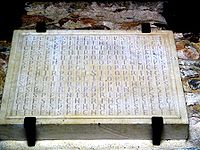
Church of San Juan Apóstol y Evangelista, Santianes de Pravia
Encyclopedia
St. John Apostle and Evangelist is a Roman Catholic Asturian
pre-Romanesque
church situated in Santianes de Pravia
, northern Spain
.

 The foundation stone in the form of a letter labyrinth ("Silo Princeps Fecit") inspired the hypercube of Salvador Dalí
The foundation stone in the form of a letter labyrinth ("Silo Princeps Fecit") inspired the hypercube of Salvador Dalí
's painting A Propos of the "Treatise on Cubic Form" by Juan de Herrera, housed in the Museo Reina Sofia, Madrid
.
The inscription Silo princeps fecit singularly combined in fifteen horizontal lines and nineteen perpendicular columns of letters. The T forms the beginning and the end of the first and last line in consequence of which the name Silo is not to be found till the eighth line and the S which begins it is exactly in the centre of that line and of the tenth column thus the name is in the shape of a cross as the letters above below and on each side of the S form the word Silo.
Asturias
The Principality of Asturias is an autonomous community of the Kingdom of Spain, coextensive with the former Kingdom of Asturias in the Middle Ages...
pre-Romanesque
Pre-Romanesque art
Pre-Romanesque art and architecture is the period in Western European art from either the emergence of the Merovingian kingdom in about 500 or from the Carolingian Renaissance in the late 8th century, to the beginning of the 11th century Romanesque period...
church situated in Santianes de Pravia
Santianes (Pravia)
Santianes is one of fifteen parishes in Pravia, a municipality within the province and autonomous community of Asturias, in northern Spain.The population is 641 .-Villages and hamlets:* Bances* Los Cabos* Santianes...
, northern Spain
Spain
Spain , officially the Kingdom of Spain languages]] under the European Charter for Regional or Minority Languages. In each of these, Spain's official name is as follows:;;;;;;), is a country and member state of the European Union located in southwestern Europe on the Iberian Peninsula...
.
Cultural references


Salvador Dalí
Salvador Domènec Felip Jacint Dalí i Domènech, Marquis de Púbol , commonly known as Salvador Dalí , was a prominent Spanish Catalan surrealist painter born in Figueres,Spain....
's painting A Propos of the "Treatise on Cubic Form" by Juan de Herrera, housed in the Museo Reina Sofia, Madrid
Madrid
Madrid is the capital and largest city of Spain. The population of the city is roughly 3.3 million and the entire population of the Madrid metropolitan area is calculated to be 6.271 million. It is the third largest city in the European Union, after London and Berlin, and its metropolitan...
.
The inscription Silo princeps fecit singularly combined in fifteen horizontal lines and nineteen perpendicular columns of letters. The T forms the beginning and the end of the first and last line in consequence of which the name Silo is not to be found till the eighth line and the S which begins it is exactly in the centre of that line and of the tenth column thus the name is in the shape of a cross as the letters above below and on each side of the S form the word Silo.
External links
- http://www.archive.org/details/moslemarchitectu00rivouoft

